version one, supplemented
Note, this is an old article from 2007. Have since changed windows versions, range of ADSL modems, steel more modern computers (eg, network Card is now almost always built into motherboard), sites with firmware do not work. But the basic points, of course, have not changed.
Notes:
* Perhaps you will find it useful or.
a) The article was written for those who want to independently connect to ADSL, saving money on setting up and installing software, without being an experienced user or specialist. If you are setting up Cisco on dark autumn evenings, then you obviously have nothing to do.
b) None of the terms and concepts pretend to be scientific, accurate, and correct formulation, this is done intentionally so as not to load the reader's mind with wordy periods and other nonsense. I wrote this article for friends and acquaintances who ask to "configure ADSL" - so as not to explain every time anew, but just to provide a link.
c) For untrained users: do you read and do not understand anything? Go straight to the practical part.
e) Author assumes no responsibility for any damage caused by this article... Don't agree - don't read. In doubt, call a technically competent user or order the installation of equipment and software configuration from the operator. For my part, I did my best to make everything go smoothly and simply for you.
Theoretical part:
1) What is ADSL
2) AnnexA and AnnexB
3) USB or LAN?
4) Router or bridge?
5) Line requirements
6) Do you need a driver for ADSL modem?
7) How to connect two or more computers to ADSL?
Practical part:
5) Purchase of equipment
6) Equipment connection
7) Configuring the modem in bridge mode (for example, Acorp LAN 120)
8) Setting up a connection with a provider
9) Traffic accounting
Optional additions:
10) What's inside the splitter
Theoretical part
What is ADSL?
ADSL is a digital technology for accessing a network at high speed over a telephone line (not necessarily a telephone line). In this case, the phone operates in one frequency range, and the communication channel with the provider for accessing the network - in another. The phone is always free.
Annex A and AnnexB
If the apartment has a burglar alarm, an AnnexA ADSL connection is usually not possible. But if there are ports on the AnnexB PBX, you will be connected without problems. You can be connected to AnnexB even if you don't have any alarm at home. For example, if the AnnexA ports are all already occupied, and the AnnexB ports are free. There is a potential opportunity in the future to switch from AnnexB to AnnexA and vice versa (in the event of a technical possibility on the PBX). Of course, if you are connected to the AnnexB port, you will need an appropriate modem (and the same AnnexB splitter, especially if you actually have an alarm). The AnnexB modem will not work with the AnnexA port. You can find out which port you will be connected to in the technical support service of your ADSL operator. In any case, it is necessary to clarify the type (and even the brand) of the purchased modem before purchasing. Often, after the conclusion of the contract, the papers clearly indicate which port you were connected to. If the ADSL light on the modem is off, it means one of three things: you have not yet been connected to the ADSL service, your modem is of the AnnexB type, but you are connected to AnnexA, or vice versa, or you have a faulty telephone wiring in your apartment.
ADSL modems can be connected to a computer via a USB interface or via a network card. The first option (USB) cannot be considered satisfactory, because such a connection is fraught with instability, however, there are many examples when everything works quite stably and reliably. The advantage of this option is that there is no need to purchase a network card. The second option (LAN) is more reliable and in many ways more convenient, but for this you have to buy a network card and install it inside yourself system unit (described in the practical part of the article). Some modems allow you to connect a modem both via USB and LAN, for example Acorp [email protected] Lan 120. The kit contains two cables, and on the back of the modem there are two different sockets.
Router or bridge?
The modem can operate in two modes: bridge or router. In the first case, you will click, for example, on the shortcut on the desktop, and connect to the network in the usual way, as you did before when connecting via a regular modem (not ADSL). This connection method is described in this article. It is useful for beginners and ordinary home users who have only one computer connected to the network. In the second case, the modem connects to the network itself, while the command to connect is sent from the modem's web control panel and is disabled there. Convenient for connecting several computers to the network (then it is advisable to buy a modem with additional LAN connectors, for example, Acorp [email protected] Lan 420, which has four such slots, moreover, this model does not have USB interface). The router mode is also useful in some other cases, the description of which is outside the scope of this article.
Line requirements
Not all ADSL lines work or work stably. It all depends on the distance from the PBX, the quality of the wiring from the PBX to the house, and the state of the internal wiring. Usually, operators do not recommend connecting more than two telephones to the line (of course, they must be connected through a splitter, more about this in the practical part of the article). Sometimes the operator may offer to order a replacement wiring from the junction box at the entrance to the apartment. It may be necessary to replace the old-style telephone cable (so-called "noodles") with a modern twisted one. But in any case, such work should be carried out after you have made sure that the connection is unstable, and unstable precisely through your fault, and not, for example, because of problems at the PBX or an eternal damp basement, where the cable sags after each rain ...
Do i need a driver for my ADSL modem?
The driver is only needed for a USB ADSL modem, usually it comes with the modem itself. If you connect via a network card and you have a LAN modem, you do not need to install any driver. There are modems that have both a USB input and a LAN, if you decide to connect using the first option, you need to install a driver, if you do not need to install anything using the second option.
How to connect two or more computers to ADSL?
The easiest way is to buy a modem with additional LAN connectors, for example, Acorp LAN 420 with a four-port switch, you can plug four network cables into this modem and provide an appropriate number of machines with the Internet. Another option is to buy a switch in addition to the modem, configure the modem in router mode, while it will work as a gateway / router through NAT, the details of such a connection can be found on the Internet.
Practical part
Equipment purchase
We need three devices: an ADSL modem, a network card, and a splitter (maybe more than one).
First of all, you need to agree on the model of the purchased modem with the ADSL operator. It is advisable to call technical support and to clarify everything. Sometimes, when concluding a contract, operators give a booklet where they list the most suitable modems. In fact, the model here is not so important (all of them, one way or another, do the same thing, however, in rare cases there are compatibility problems), how much compliance with AnnexA or AnnexB to the port to which you are connected or are going to be connected (see more in the theoretical part). If you are connected to AnnexB, the choice of models is limited, mainly a couple of three devices from Acorp (by the way, changing the firmware in Acorp LAN 120 you can turn it into either AnnexA or AnnexB), Zyxel P660RU, and a couple of D-Link modems, for example D-Link 564T. Be sure to tell the retailer which modem you need - AnnexB or AnnexA. The most popular ADSL modems cost from 900 to 2500 rubles.
Network Card
You can take any inexpensive 10/100 Ethernet network card with an RJ-45 connector on PCI bus... It is advisable to buy a set (modem, network card, splitters) right away, in one store, so that the seller understands why you need it and does not foist on some expensive 1 gigabit network card for a thousand rubles. Currently, an inexpensive network card costs from 100 to 200 rubles.
Splitter
Some modems come with a splitter. Let's assume that you have a more or less standard layout and only need one splitter. Then, when buying a modem, check if it is included in the kit. Usually the splitter is included with D-Link and Zyxel modems. But in the case of Acorp, the splitter may be absent. Check with the seller, see the list of accessories on the box with the modem. If there is no splitter in the kit, buy one. Splitters, like modems, are AnnexA and AnnexB. Get a splitter that matches your modem. If you can't find the right one, don't despair. In principle, a splitter is necessary so that the ADSL signal does not gurgle in the handset. The principle of the splitter is such that it cuts off frequencies above a certain value. The AnnexB splitter has a higher cut-off, leaving a bandwidth for eventual signaling. If you do not have an alarm at home (and a non-ISDN line) - most likely there will be no problems even if you have an AnnexB modem, but an AnnexA splitter. In the simplest case, when you do not have a telephone set at all, and the line is used purely for accessing the network, a splitter is not needed at all. By the way, it is not necessary to plug the modem into the “Modem” splitter connector. Be aware that the Line input is always shorted directly to the Modem output. Take this into account when optimizing the telephone wiring in the apartment, and do not enter into various stupid instructions, which are full on the network, when all sorts of teapots urge you to stick the modem only into the splitter, and nothing else. A splitter usually costs between 50 and 200 rubles.
Equipment connection
Imagine a situation that you have two telephones in your apartment, connected in parallel and a modem socket.
The splitter has three jacks: "Line", "Modem", "Phone". We connect the telephone line entering the apartment to the “Line” jack, to the “Phone” jack a branch with parallel telephones (all phones must be connected to the line through a splitter). You can plug a modem cable into the Modem jack. (The diagram is shown a little differently, but, in fact, the same thing - the modem is directly connected to the line. Moreover, if you plug it into the Splitter's Modem jack, you will achieve exactly the same effect - this jack inside the splitter is shorted directly to Line "). What if the phones are spread around the apartment? Buy another splitter or microfilter (splitter without "Modem" slot). Then connect each phone through its own individual splitter. Do not confuse the "Modem" and "Phone" jacks, it seems to be a primitive but very common mistake.

Next, let's start installing the network card. You will need a Phillips screwdriver. Turn off your computer. Disconnect it completely from the mains by unplugging the power plug. Open the system unit (case design is different, sometimes it is necessary to completely remove the casing by unscrewing four screws on the back of the system unit, and sometimes it is enough to unscrew two screws and move one of the walls back). Find a free PCI slot (usually white), firmly but carefully insert the network card into it, screw the card bracket with a screw, close the system unit. Turn on your computer. Download operating system... Windows should find your card and most likely you won't even need to install drivers. Otherwise, install the driver from the floppy disk or CD that comes with the network card. If everything went well, in "Start" -\u003e "Control Panel" -\u003e "System" -\u003e "Hardware" -\u003e "Device Manager" you will find the new device in the Network Cards section.
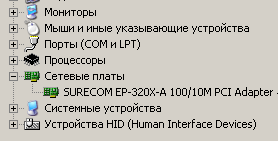
If the device is crossed out with a red cross or marked exclamation mark, or it is not listed - the installation failed. See if the network card has been detected twice. Sometimes it happens that Windows independently identified and installed the card, and you additionally installed the driver, it turned out like two devices. Delete the unnecessary (right-click menu on the device name) that you installed yourself, and for the rest update the driver (right-click menu -\u003e update driver) by manually specifying the path to the driver on the disk that came with the network card. After successful installation, an icon with the image of two monitors, a red cross, and the inscription "Network cable not connected" will appear in the tray (near the clock in the lower right corner). This means that everything is going fine.
Pull the modem out of the box, get it network cable (it looks like a telephone one, but the connectors on it are a bit wider), we connect one end to the network card socket behind the system unit, and the other to the modem. Acorp LAN 120 calls this socket LAN. Now connect the modem to the telephone socket or the "Modem" socket of the splitter using a standard telephone cable (sometimes called "ADSL cable" in the instructions for the modem) - it comes with the modem.
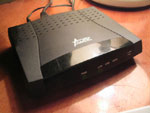

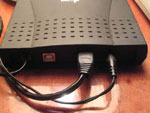
Before the telephone socket, no phones, faxes, analog dial-up modems, and other things should be connected directly to the line, all these devices are connected only through a splitter! Remember the rule: you can connect an ADSL modem directly to the line, everything else is not done - only through a splitter. Next, we take out the modem's power supply, one end into the “Power” socket on the modem, the other into the mains. Two lights will light up: PWR and LAN. It's okay. By the way, now the monitors tell us (if you hover the mouse cursor) that a connection has been established with a speed of 100 megabits. The equipment connection is complete. Now you need to configure everything.
Configuring a modem in bridge mode (for example, Acorp LAN 120 (420)
We will configure the modem in bridge mode. Note: on the website beta.acorp.ru ( in this moment site does not exist) posted wizards (connection wizards) that will help you configure the modem and network connections in automatic mode... The program will ask several necessary questions and configure everything by itself. But it's better not to rely on software for dummies, but to master everything yourself. Moreover, this article is written just for inexperienced users. And wizards can fail.
The first step is to follow the instructions in the manual. "Start" - " Network connections"-" The name of your connectionthat appeared after installing the network card. " On the General tab, highlight the Internet Protocol (TCP / IP) line and click the Properties button.

Set the Obtain an IP address automatically and Obtain a DNS address automatically options. Save the parameters with the "OK" button.

If you use Far or Total Command, enter commands in the com line, and if you do not know what it is, the button "Start" - "Run", sequentially dial ipconfig / release, and then ipconfig / renew.
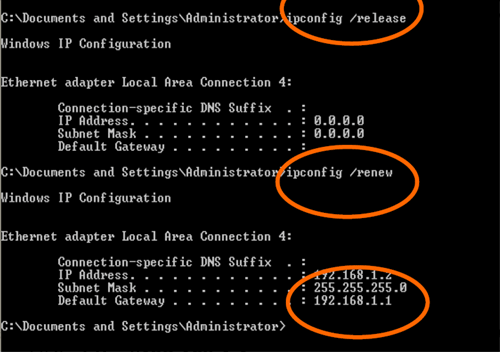
Note that the Default Gateway is 192.168.1.1. This is the standard address of the modem, we will use it using a browser for subsequent configuration.
Launch your browser ( Internet Explorer, Firefox, Opera), type 192.168.1.1 in the address bar. For Username and Password enter the word Admin (the first letter for Akorp should be capitalized, but for some other modems it should be small). Click the Log In button in the lower right corner.

After that we will get to the web interface for managing the modem. IN top menu find the WIZARD item and enter there. In the top line of Protocol, select Bridge. Something like this will appear:
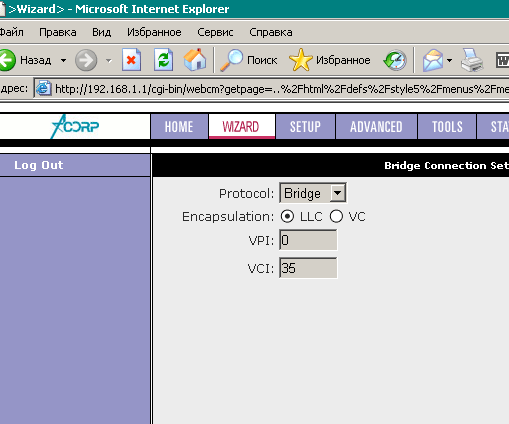
Your ADSL operator should have provided you with the Encapsulation, VPI and VCI values \u200b\u200bat the time of the contract. If this does not happen, call technical support. Each operator has different values. If you put it wrong, the internet will not work or will be unstable. In the lower right corner, click the Next button and then Save / Restart. The settings will be saved in the flash memory of the modem and a reboot (of the modem) will take place. At the same time, a message will flash that your network connection disconnected and then reconnected. You will need to log into the web interface again. Next, go to the SETUP menu and select Modem on the right. Set the modulation type. Usually it is also indicated by the operator when concluding a contract.
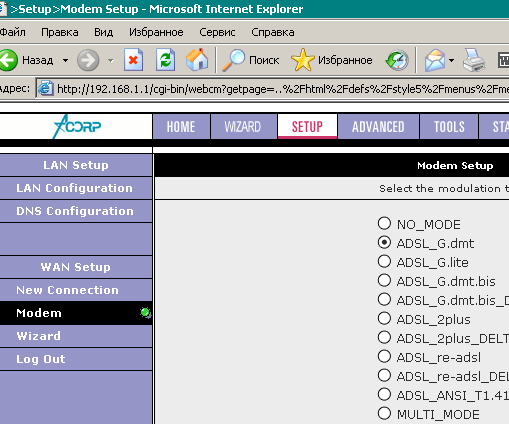
Complete the setup, for which in the TOOLS menu, select the System Commands item, And successively press the Save All and Restart buttons. The modem will reboot again, but you no longer need to enter the web interface settings. Close your browser.
Note: Similar setting works in the overwhelming majority of cases, but some operators require other parameters to be set.
So, there are three lights on the modem: Power, LAN, and ADSL. If the ADSL light is off, this means one of three things: you have not yet been connected to the ADSL service, your modem is of the AnnexB type, and you have been connected to the AnnexA, or vice versa, the telephone wiring in your apartment is faulty. The first two options will help you resolve the technical support.
By the way, in the case of the Acorp modem, it is enough to change the firmware to make an AnnexB modem from an AnnexA or an AnnexB from an AnnexB. The firmware and technology of this operation for the Acorp modem are taken from the sites: beta.acorp.ru and mcmcc.bat.ru/acorp/ (at the moment the sites do not exist). Remember, by installing the wrong firmware or for some other reason, you run the risk of screwing up the modem and throw it into the trash... Recovery techniques exist, but they are complex and may not be within your reach.
Configuring a connection with a provider
Now we will create a connection through which you will connect to the Internet. Let me remind you that you already have a network connection between your computer (network card) and a modem. Now you need to create a modem connection to the Internet. If you have Windows XP, you do not need to install additional software. In the case of Windows 2000, you need to download from the network additional package WinPoET and enter username and password in this program. We will look at the setup methodology in Windows XP.
"Start" -\u003e "Settings" -\u003e "Control Panel" -\u003e "Network Connections". On the right, click on the "Create a new connection" menu -\u003e "Next" button -\u003e "Connect to the Internet" checkbox -\u003e "Next" button -\u003e "Set up a connection manually" checkbox -\u003e "Next" button -\u003e "Via high speed connectionrequesting a username and password "-\u003e Enter an arbitrary name for the connection -\u003e button" Next "-\u003e Enter the username and password (password in two places) received from the ADSL operator when concluding a contract -\u003e button" Next "-\u003e checkmark" Add connection shortcut to desktop "-\u003e button" Finish ". That's it, with this shortcut you connect to the Internet.
To make the connection icon flash in the tray, in the connection properties ("Start" -\u003e "Settings" -\u003e "Control Panel" -\u003e "Network Connections" -\u003e the name of your connection -\u003e right mouse button on the icon - "Properties" -\u003e set check the box "When connected, display the icon in the notification area" -\u003e "OK" button). Similarly, you can do the network card-modem connection.
If you get an error when trying to connect to the Internet, check if there is a connection between the network card and the modem. If not, activate it "Start" -\u003e "Settings" - "Network connections" - the name of the connection. And don't get confused. You two working connections: network card - modem and modem - internet. Both are needed and must be active when normal work with the internet.
The setup is complete, connect to the world network using the shortcut on your desktop and monitor the traffic if you have no limit. 🙂
Typical questions and answers
Question: I have an ADSL modem and an unmanaged switch, can I distribute the Internet to several computers?
Answer: Without going into technical details - this is a buggy connection option. The Internet will be on one machine + other problems. Buy a four-port ADSL modem.
Optional addition
What's inside the splitter?
Inside the splitter are capacitors and chokes with ferrite cores.

2007 (c) Maxim Samohvalov
ADSL technology
In recent years, the growth in the volume of information transmission has led to the fact that there is a deficit in the capacity of access channels to existing networks. If at corporate levels this problem is partially solved (by leasing high-speed transmission channels), then in the apartment sector and in the small business sector these problems exist.
Today, the main way end users interact with private networks and networks common use is access using a telephone line and modems, devices providing transmission digital information on subscriber analog telephone lines. The speed of such a connection is low, the maximum speed can reach 56 Kbps. This is still enough for Internet access, but the saturation of the pages with graphics and video, large volumes email and documents in the near future will again raise the question of ways to further increase the capacity.
The most promising currently is the ADSL technology (Asymmetric Digital Subscriber Line). It is a new modem technology that transforms standard analog subscriber lines into high-speed access lines. ADSL technology allows you to transfer information to the subscriber at a speed of up to 6 Mbit / s. In the opposite direction, a speed of up to 640 kbps is used. This is due to the fact that the entire modern range of network services assumes a very low transmission speed from the subscriber. For example, to receive MPEG-1 videos, you need a bandwidth of 1.5 Mbps. For the service information transmitted from the subscriber, 64-128 Kbps is quite enough (Fig. 1).
Organization principles of ADSL service
The ADSL service (Figure 1) is organized using an ADSL modem, and a rack of ADSL modems called the DSL Access Module. Almost all DSLAMs are equipped with a 10Base-T Ethernet port. This allows conventional hubs, switches and routers to be used at the access points.
A number of manufacturers have started to provide DSLAMs with ATM interfaces, allowing them to be directly connected to ATM WAN switches. Also, a number of manufacturers create custom modems, which are ADSL modems, but for software are ATM adapters.
In the section between the ADSL modem and the DSLAM, there are three streams: a high-speed stream to the subscriber, a bidirectional service channel and a voice channel in the standard frequency range of the PM channel (0.3-3.4 kHz). Frequency separators ( POTS Splitter) allocate a telephone stream, and direct it to a regular telephone set. This scheme allows you to talk on the phone simultaneously with the transfer of information and use telephone communication in the event of a malfunction of the ADSL equipment. Structurally, the telephone splitter is a frequency filter that can be either integrated into an ADSL modem, or be an independent device.
According to the theorem Shannon, it is impossible with the help of modems to reach speeds higher than 33.6 Kbps. In ADSL technology, digital information is transmitted outside the frequency range of a standard PM channel. This will cause the filters set to telephone exchange cut off the frequency above 4 kHz, therefore, it is necessary to install equipment for access to wide area networks (switch or router) at each telephone exchange.
Transmission to the subscriber is carried out at speeds from 1.5 to 6.1 Mbit / s, the service channel speed is from 15 to 640 Kbit / s. Each channel can be split into multiple logical low speed channels.
The speeds provided by ADSL modems are multiples of the speeds of digital channels T1, E1. In the minimum configuration, the transmission is carried out at a speed of 1.5 or 2.0 Mbit / s. In principle, today there are devices that transmit data at a speed of up to 8 Mbit / s, but this speed is not defined in the standards.
Speed \u200b\u200bof ADSL modems depending on the number of channels
| Base speed | Number of channels | Speed |
|---|---|---|
| 1.536 Mbps | 1 | 1.536 Mbps |
| 1.536 Mbps | 2 | 3.072 Mbps |
| 1.536 Mbps | 3 | 4.608 Mbps |
| 1.536 Mbps | 4 | 6.144 Mbps |
| 2.048 Mbps | 1 | 2.048 Mbps |
| 2.048 Mbps | 2 | 4.096 Mbps |
| 2.048 Mbps | 3 | 6.144 Mbps |
The maximum possible line speed depends on a number of factors, including the length of the line and the thickness of the telephone cable. The characteristics of the line deteriorate with an increase in its length and a decrease in the wire section. The table shows several options for the dependence of the speed on the line parameters.
An ADSL modem is a device based on a digital signal processor (DSP or DSP) similar to that used in conventional modems (Fig. 2). In general, the entire line capacity is divided into two sections. The first section is intended for voice transmission, and is in the range of 0.3-3.4 kHz. The signal range for data transmission is from 4 kHz to 1 MHz. The physical parameters of most lines do not allow data transmission with a frequency of more than 1 MHz. Unfortunately, not all existing telephone lines (especially long-distance ones) even have such characteristics, therefore it is necessary to reduce the bandwidth, which entails a decrease in the transmission speed.
Two methods are used to create these streams: the c frequency division channels and echo cancellation method.

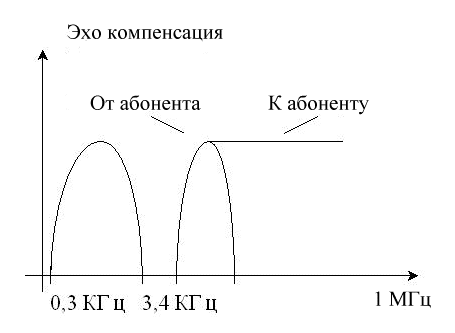
Figure: 3 Streams dividing schemes in the bandwidth of telephone line frequencies
The frequency division method is that each of the streams is allocated its own frequency bandwidth. The high speed stream can be split into one or more low speed streams. These streams are transmitted by the " "(DMT).
The echo cancellation technique is that the ranges of the high speed and overhead streams overlap. Separation of streams is carried out using a differential system built into the modem. This method is used in modern V.32 and V.34 modems. The high-speed stream can be divided into one or more low-speed streams. These streams are transmitted by the " discrete multi-tone modulation"(DMT).
When transmitting multiple streams, each of them is divided into blocks. Each block is supplied with an Error Correction Code (ECC).
Related technologies
There are a number of related technologies, some of which are intended for end users, others for the transit of high-speed streams. Their principle of operation is similar to that of ADSL. The common name for such technologies is xDSL.
High Data-Rate Digital Subscriber Line (HDSL)
HDSL is a technology that can transmit at 1.536 or 2.048 Mbps in both directions. The length of the line can be up to 3.7 km. Designed as a cheaper alternative to dedicated E1, T1 channels. Requires a four-wire subscriber line.
Single-Line Digital Subscriber Line (SDSL)
It is similar to HDSL, it differs in that a two-wire subscriber line is sufficient to organize the line. The length of the line can be up to 3 km.
Very High Data-Rate Digital Subscriber Line (VDSL)
Same as HDSL, up to 56 Mbps. Distance up to 1.5 km. The technology is very expensive and is not widely used.
Rate Adaptive Digital Subscriber Line (RADSL)
ADSL technology has one major drawback. It does not allow changing the speed depending on the quality of the line. In such modems, the choice of speed, a multiple of 1.5 or 2 Mbit / s, is made using software. The equipment built on the basis of RADSL technology allows to automatically reduce the speed depending on the quality of the line.
Universal ADSL (UADSL)
ADSL technology has a number of minor drawbacks that impede widespread adoption of the technology on subscriber access networks. This is the complexity of installing ADSL devices; they require serious tuning to a specific subscriber line (as a rule, with the participation of a technical employee of the company - the network operator), and are relatively expensive.
Not so long ago, there were messages about the creation new version ADSL technology, which is designed to eliminate these disadvantages. It is called Universal ADSL (UADSL), or DSL Lite. True, when using this technology, data is transmitted at lower speeds than in ADSL (with a subscriber line length of up to 3.5 km, the speed is 1.5 Mbit / s in the direction to the subscriber and 384 kbit / s in the opposite direction; with a length of subscriber lines up to 5.5 km are provided with 640 kbps towards the subscriber and 196 kbps in the opposite direction). However, these devices are easier to install; in addition, they include a frequency divider, so it does not have to be installed separately. Basically, it is enough to simply plug the UADSL modem into a telephone wall jack, just like a normal modem.
The cost of such devices does not exceed the cost of a conventional modem; therefore, it is expected that this particular technology will find wide application in end-user access equipment.
Standards
The American National Standards Institute (ANSI) Working Group T1E1.4 recently approved a standard for ADSL up to 6.1 Mbps (ANSI Standard T1.413). ETSI has supplemented this standard with European requirements. T1.413 defines a single terminal interface for the operator. The second version of this standard, developed by the T1E1.4 group, expanded the standard in which it defined: multiplexed interface from the operator's side; configuration protocols and network management.
Few numbers
Distances for short range modems depend on the diameter of the copper pair:
1. Telindus Crocus HDSL 2048Kb / s:
| Wire diameter (mm) | 2-pair version (km) | 3-pair version (km) |
|---|---|---|
| 0.4 | 3.6 | 4.0 |
| 0.5 | 5.0 | 5.5 |
| 0.6 | 7.1 | 7.8 |
| 0.8 | 8.9 | 9.9 |
| 1.0 | 12.5 | 13.9 |
2. Telindus Crocus SDSL:
| Wire diameter | 384 Kbit / s | 768 Kbit / s | 1152 Kbit / s |
|---|---|---|---|
| 0.4 mm | 5.0 Km | 4.3 Km | 3.6 Km |
| 0.5 mm | 6.9 Km | 6.0 Km | 5.0 Km |
| 0.6 mm | 9.8 Km | 8.4 Km | 7.1 Km |
| 0.8 mm | 12.4 Km | 10.6 Km | 8.9 Km |
| 1.0 mm | 17.3 Km | 14.9 Km | 12.5 Km |
| 1.2 mm | 19.3 Km | 16.6 Km | 13.9 Km |
3. Telindus Crocus HS (144Kb / s):
| Wire diameter (mm) | distance (km) |
|---|---|
| 0.4 | 6.9 |
| 0.5 | 9.5 |
| 0.6 | 13.5 |
| 0.8 | 17.5 |
| 1.0 | 26.0 |
Supplement1
The article is well written, everything is correct, however there are some comments regarding the implementation of ADSL in real life. Unfortunately, on ordinary Russian communication lines, ADSL can only be used as an experiment, there is no talk of industrial operation so far. For an ADSL line, a TWISTED pair (not noodles) is required, and shielded, and if it is a multi-pair cable, then in compliance with the direction and pitch.
You can object (S.Zh.), noting that the noodles go only in the section from the cross in the house to the apartment, its replacement with a twisted pair cable does not present both technical and economic difficulties. On the cross-telephone exchange site, multi-pair cables are used, where each pair is twisted.
It seems to be convincing BUT have you tried to disassemble the telephone cable? Remove the insulation meter from the imported cable and from the domestic one. The imported one will dissolve into twisted pairs that will not fall apart even if you pull them, and the domestic one almost immediately turns into a broom and it takes a fair amount of skill to cut it without additional devices. Replacing the noodles also does not seem to be scary, but after all, noodles will not do here, you will need to replace the KRT (telephone distribution box), especially if it is plastic (remember how LANs are divorced) and it stands in each entrance and often not one at a time. The direction of winding in domestic multi-pair cables is not respected (for example, consider our 50-pair cable or 100-pair cable), because no one thought that such cables would be used to transmit broad-spectrum high-frequency signals, respectively, and no one is also about protection against crosstalk thought about it. For the capitalists, perhaps this benefit also arose by chance, because there is competition and in order for products to be bought, it must correspond not even to the mandatory, but to the parameters recommended by all sorts of commissions (because these commissions do not eat their bread for nothing) and on the territory of one region (or even blocks) may have two or more telephone service providers. Vooschem, as always, thanks to competition, quality goods and services are obtained.
For E1 used twisted pair already with two screens isolated from each other along the length of the cable and with a regulated number of cable spans, otherwise there is no need to talk about any mileage and stable connection.
This is true, but in my opinion (S.Zh.) DSL technology is more likely to find its application not in industry, but in the apartment sector.
Yeah, here's what I can add (I.Sh.), a couple of years ago this technology was offered to ROSTELECOM for the reconstruction of short highways, and the trunk cable is not your home wiring for such a cable, you can skip 64 Mbit and this modernization was built according to the station- cable station. Well, ROSTELECOM did not agree to use these technologies, because it is expensive. I doubt that now the equipment has become so cheap that it costs like an Ethernet hub? And if I'm wrong, then someone wants to warm their hands on the modernization of cable lines and the introduction of new technology.
Well, now let's imagine that 2-6 Mbit is launched into the telephone cable, and it (the cable) does not have the appropriate parameters (often the wire insulation is underestimated - well, the poor fellow was soiled, probably heard cod and space talks in the tube), as a result, pickups will climb out ... I think that these pickups will be the result of combinatorial frequencies, and a very wide spectrum, which will create such interference to television receivers that a real war can begin. So, in practice, not everything is smooth yet, unfortunately.
That is why, personally, I think (S.Zh.) that it is much more relevant to implement UADSL with low speeds (up to 640 Kbps). All the indicated effects in this technology will be expressed to a much lesser extent.
I think (I.Sh.) that all the same, the price of such an implementation will be too high at this stage to seriously think about it. So, here more problemsthan it seems at first glance, and in any case, a more serious approach is required.
And here is my information (S.Zh.): providers, in particular Rosnet, do not share your views on technical problems and can provide ADSL equipment. Installing a modem, setting up, connecting, costs about $ 2,500. This provides a speed of up to 640 kbps. The monthly subscription fee is around $ 300.
ADSL modems now cost around $ 800-1500. UADSL modems should cost about $ 250-500, which is more acceptable.
As soon as each telephone center has equipment for access to data transmission networks, this type of service will become much cheaper, and the introduction of such access equipment is directly related to the introduction of ATM.
Supplement2
In the article, Stanislav Zhuravlev outlines the theoretical aspect well, but does not touch on the specifics of the application of this technology in Russia. In the first addition, some gaps are eliminated, but there are a few inaccuracies:
Firstly, xDSL technologies were developed by the research division of Bell corporation specifically for use on the existing infrastructure of copper wires, which, even in the USA, is distinguished by its old age and is built on a regular copper telephone pair, and not on a shielded twisted pair.
Secondly, "noodles" are really not suitable for xDSL lines, but "noodles" are used in the section from the telephone distribution box to the subscriber socket, which is usually about 5-15 meters. In fact, there are two limitations that, for a given line resistance (usually 1-1.5 kOhm), do not allow the use of xDSL devices, these are pupinization and assembly from wires of different cross-sections. Pupinization of a line is the introduction of an inductive component into a line in order to reduce signal attenuation, but in Russia such lines are almost never used. The second problem occurs quite often, but if the station part of the equipment is located on the PBX nearest to you, then the likelihood of such a problem is small, in any case, this problem can be solved with a local telephone exchange. However, if you need a direct channel, for example, to connect two local area networksthen this is not a problem either. In Moscow, there is a fairly large number of direct channels operating on copper at a distance of 5-7 km and a resistance of 1-1.5 kΩ.
The widespread use of xDSL technologies in Russia is constrained, first of all, not by an insufficient number of telephone pairs with acceptable parameters (while the number of installed lines in Moscow is estimated at tens or hundreds), but by the price of equipment, $ 2000-3000 per set of station and subscriber parts, by the price of connection and the cost of a dedicated channel (for the sake of curiosity, look at any of the providers how much a 64K synchronous channel costs, the prices will unpleasantly impress you). The speed of already installed lines usually ranges from 64-512K. I have never seen xDSL lines operating at a speed of more than 2Mbit on copper and I think their appearance is unlikely in the near future. This is explained by the fact that the cost of a 2Mbit stream is so high that either very large commercial firms or telecommunications companies that provide services themselves can afford it, and for them such a criterion as the probability of an error on the channel is very important. The smallest error probability is provided by optical fiber, the stability of which will in any case be several orders of magnitude higher than xDSL lines.
It seems to me that the most promising prospects have equipment designed for a speed of 64-512K, especially created in accordance with the UDSL standard, which should be adopted by the end of this year. Manufacturers promise the price of a subscriber UDSL modem no more than $ 300-400. If large telecommunications companies are interested in providing xDSL services (the ideal case is MGTS: -)), which will be able to place station sets of equipment on a large number of telephone nodes at their own expense, we will expect a sharp increase in the number of xDSL lines used in the near future.
0 Members and 1 Guest are viewing this topic.






